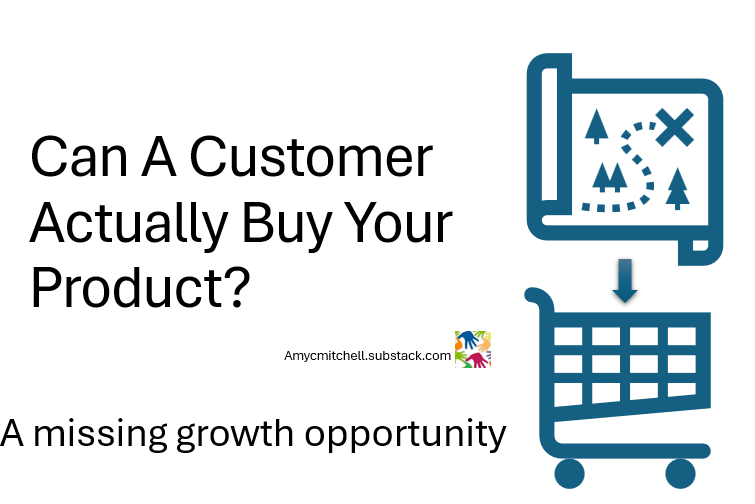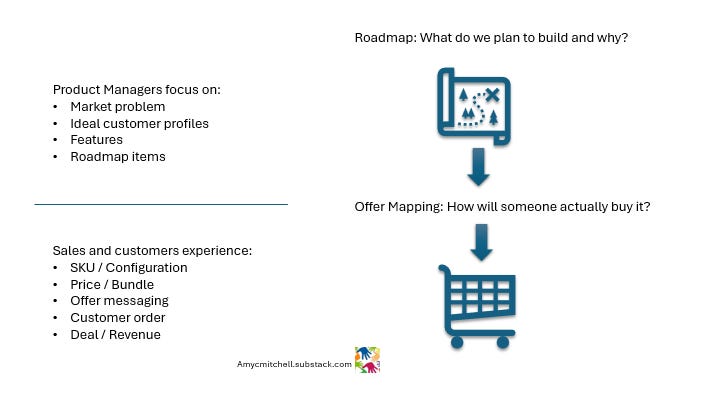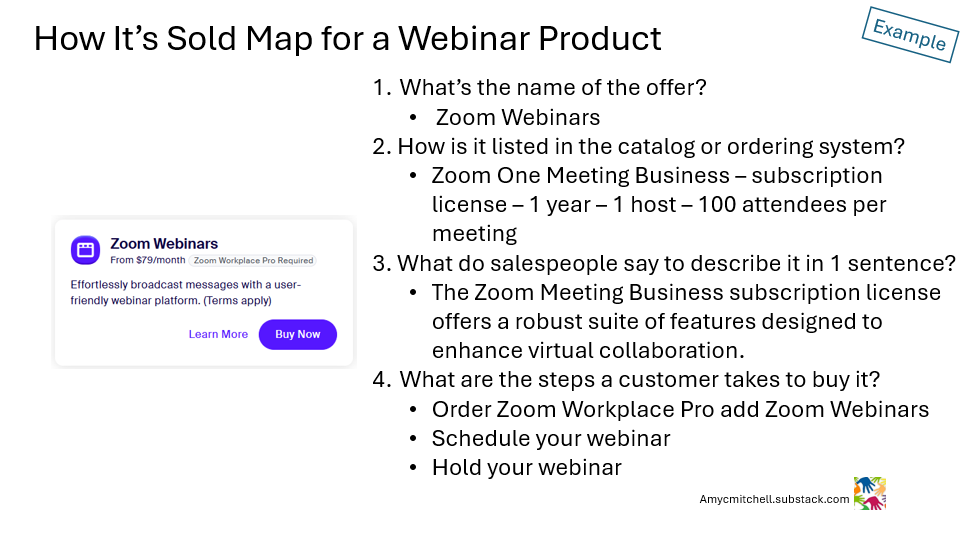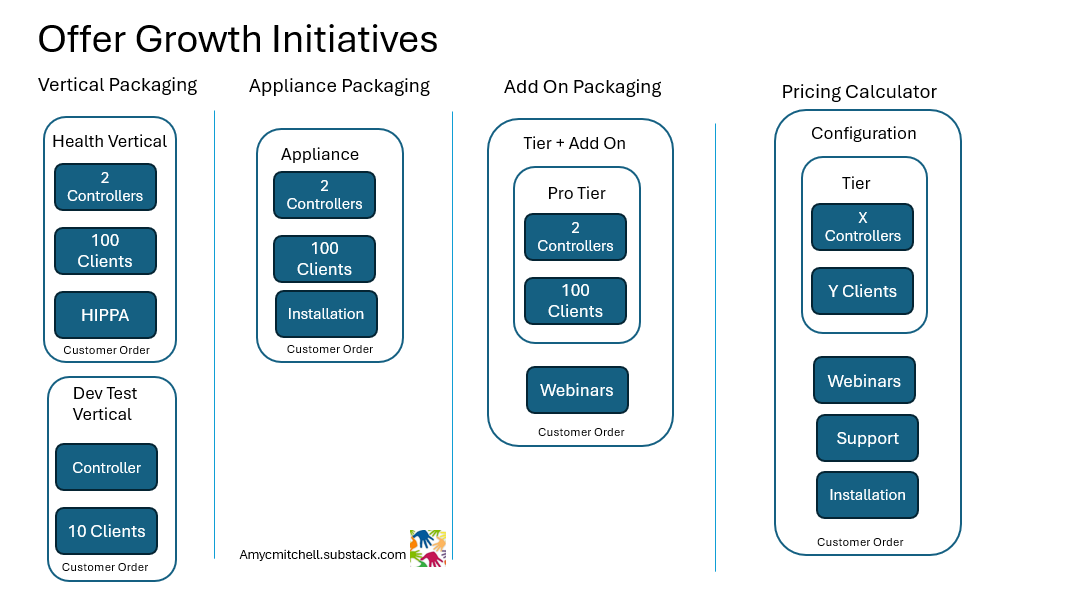Can a Customer Actually Buy Your Product?
If you don’t know how your product is sold, you might be missing the growth opportunity right in front of you.
Can a customer actually buy your product?
Not what they’d use.
What they’d buy.
It’s a simple question that stops many product managers cold:
If a customer wanted to buy your product today, what exactly would they get?
Not the roadmap. Not the vision.
The thing that’s quoted, configured, bundled, shipped, and paid for.
If you can’t answer that quickly, you’re not alone. But you may have just uncovered your next growth opportunity.
The Invisible Problem: Your Product Isn’t Translating into a Sale
Sometimes the signs are subtle:
Your feature launched, but sales has no questions.
Your SKU is in the pricing system, but no one knows how to quote it.
Customers are interested — but don’t know how it helps or how to buy it.
These are signals that your product hasn’t become a buyable offer.
And in many teams, that gap lives outside the roadmap — which means no one owns it.
But when the offer isn’t clear, growth stalls — and it’s easy for product managers to get caught off guard.
Why This Happens: Smart PMs, Missing Connections
Most product managers are taught to focus on problems, customers, and features.
But in B2B, product-to-customer doesn’t go straight through UX — it passes through quoting tools, price books, and people.
And those paths are murky:
Sales works through relationships and tribal knowledge.
Ordering flows aren’t mapped.
No one explains who turns a set of SKUs into a purchase order.
You might have a beautiful sales card, but no visibility into how it's actually used.
You might assume your offer is “done” — while sales sees a bag of parts, and the customer sees a complicated puzzle.
The Shift: Your Offer Is Part of Your Product
A product becomes an offer when it’s packaged, positioned, and ready for someone to buy.
That last part that gets sold — from SKU to solution — is often overlooked. But it’s where growth lives.
If you don’t know how your product is sold, you can’t know how it’s adopted.
If you can’t see how it’s bundled, quoted, or transacted, you can’t shape real growth.
The good news?
You already have the skills. You map customer journeys. Now, map the buying journey.
That’s where the How It’s Sold Map comes in.
The Tool: Build Your How It’s Sold Map
This isn’t a framework. It’s a prompt.
You can build it in 20 minutes — or stretch it across a few conversations.
Here’s what to ask:
What’s the name of the offer?
It may differ from the product name; check the catalog or sales site for accuracy.How is it listed in the ordering system?
Look for SKUs, tiers, bundles, add-ons.What do salespeople say to describe it in 1 sentence?
Ask them. You'll learn more than from any deck.What are the steps a customer takes to buy it?
From quote → purchase order → delivery → install → go-live.Where does the process break down?
Confusing bundles, approval delays, misaligned SKUs.What other offers is it usually sold with?
Is it ever sold alone? Or always as part of a broader solution?
Why It Matters: Growth Without Engineering
Your roadmap adds features.
But your offer — once you know it — can unlock growth without engineering changes.
You can:
Repackage it for a high-growth segment (e.g., healthcare, financial verticals)
Create “appliance” bundles that simplify deployment
Attach it to a better-known offer (e.g., add webinars to conferencing products)
Help sales quote solutions instead of assembling parts manually
These are product-led growth moves — driven by knowledge of your offer, not by net-new engineering.
From Offer to Solution Thinking
If you’re in B2B, your product is rarely sold alone.
Customers want outcomes, and sales assembles those outcomes from 2–5 offers at once.
So once you’ve built your How It’s Sold Map, the next question is:
Where does your offer fit in the full solution?
Understanding the bundles, sequences, and dependencies isn’t just “sales stuff.”
It’s the raw material of smarter packaging, pricing, and prioritization.
Want more on packaging your offer? Check out my Learning Path on Offer Definition, which includes How It’s Sold Map (refreshed for paid subscribers).
Conclusion: Knowing Your Offer Is Leverage
Most product managers can explain their roadmap.
Fewer can describe their offer.
Even fewer can describe the solution their offer is part of.
But the ones who can? They drive growth — without waiting for a reorg, a sales request, or an executive sponsor.
You don’t need permission to build your How It’s Sold Map.
You just need 20 minutes and the curiosity to ask:
“If someone wanted to buy this tomorrow… what would they actually get?”
Looking for more practical tips to improve your product management skills?
Check out Product Management Resources for free product management templates and guides.
Become a paid subscriber and get more weekly tips. Last week, paid subscribers learned getting a big roadmap item off the ground. Getting a Big Thing Out of the Backlog
Paid subscribers get access to 3 learning paths, 5 templates and 7 quick start guides. The newest learning path helps you develop standard offers.🎁
TLDR Product listed Product Management IRL articles recently! This biweekly email provides a consolidated list of recent product management articles.
Connect with Amy on LinkedIn, Threads, Instagram, and Bluesky for product management insights daily.






This is a great article and convinced me to be a paid subscriber! I wanted the buyer journey template!